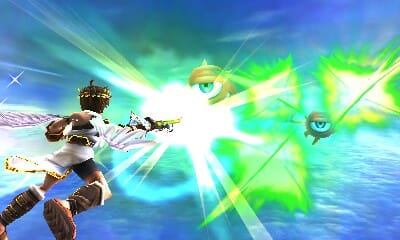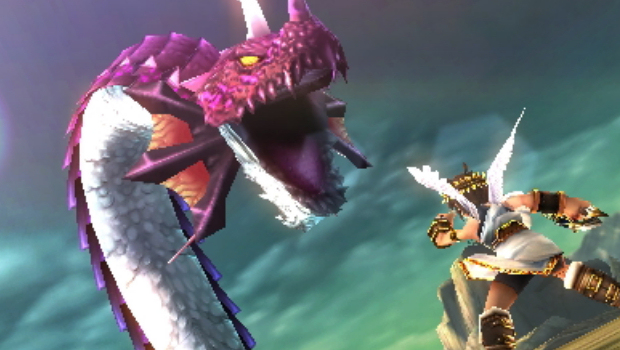
Where’s the fan outrage over this ending? Oh, right, sometimes a game is just a game. There is a story to Kid Icarus: Uprising, and characters talk to one another with real human voices, but that could all disappear and nobody would notice any difference.
Uprising is about shooting and scoring and doing it slightly better every time you play. It might seem like another slice of nostalgia from Nintendo, but that nostalgia is less for the long-neglected and largely unloved property of the title and more for the pure arcade-style action that used to define gaming and now mostly thrives on portable devices and in online shooters. Despite alternating between air and land-based sections, and despite a plethora of sometimes obtuse power-ups, Uprising is a conceptually simple game about blowing up as much stuff as possible.
That bipartite structure resembles the 1987 NES original in theory if not in practice, but beyond that and a few weapons and character designs there’s little similarity. The original Kid Icarus was part platformer and part Zelda-esque dungeon crawler, whereas Uprising is split between an on rails shooter (think Sin & Punishment) and a third-person platformer. This easily could’ve been a brand new franchise.
The first game is rightfully remembered as one of the hardest Nintendo ever made for the NES. Some of that difficulty came from a lackluster control scheme, and unfortunately that might be the other most significant thing Uprising has in common with its forebear. You will probably have to take a lot of breaks while playing Uprising. The awkward controls find you moving the main character Pit with the 3DS joystick while aiming with the stylus and firing with the left shoulder button. It’s almost unplayable without the bundled 3DS stand, but even with that the controls are cumbersome and quickly grow uncomfortable. It screams out for two analog joysticks, but that’s not even possible with the 3DS’s Circle Pad Pro attachment, which is only supported as a make-good for lefties.

Once you acclimate to the awkward controls, the acrobatic charm and competitive allure of the on rails portions are quickly apparent. Like any good shoot-’em-up, the flying sections are both fluid and rhythmic, your enemies’ projectiles laying a firm backbeat that you dance around while shooting them out of the sky. Success grants you both points and hearts, which, in the tradition of the original, aren’t health but currency. More importantly success brings you the fleeting sensations of both accomplishing something (however pointless, in at least the medium and long runs) and that deeply personal intangible known as “fun”. These moments replicate the dexterous but simple-minded pleasures of the arcade, where basic motions accelerated into blurred cycles of reflex and pattern recognition.
And then Pit loses his wings and has to hoof it. The grounded halves of each mission are rarely outright disasters, but they tend to spoil the mood. The inefficient controls come to the forefront, as the stylus is used to both aim and move the camera. A quick slash across the screen can rotate Pit’s perspective by a solid 120 degrees or so, but it’s an annoyingly imprecise way to look around your environment. Ground battles require the same essential actions, with the complicated joystick, stylus and shoulder button combo, but they also make you haphazardly spin around to locate enemies and introduce a melee attack that automatically kicks in when in close quarters. Whatever flow is found in the air disappears upon the ground.
Combat is the foundation of the game. Obviously it’s the primary draw of the three-on-three multiplayer matches, which, friendcodes aside, prove once again that the 3DS is far more dependable for online play than the Wii. One of Uprising’s more interesting wrinkles is how significantly you can tweak that combat. There are a large number of power-ups and perks that you can equip in a Tetris-style inventory puzzle (think the briefcase of Resident Evil 4), but what stands out the most is how you can wager hearts to make the game more challenging. Basically you’re betting on yourself withstanding a greater onslaught of deadlier foes in return for more loot. Each level also has certain sections that are cordoned off unless you’re playing at a certain intensity level. When you see a locked gate with a big 5 on it you’ll wish you had laid down your hearts and bumped that intensity up. Weighing the risk versus the rewards is far more compelling than just selecting one of three or four preset difficulty levels.
As befitting a game from a designer best known for the button-mashing battle royal Super Smash Bros., the joys of Kid Icarus: Uprising are almost exclusively mechanical. That’s extremely refreshing after the tedious month-long squabble over how a certain other game resolved its story. But when a game’s control scheme is tolerable at best and actively off-putting for roughly half of each level, those joys are severely curtailed. Uprising is best suited for short bursts of play. That makes it sound like a good portable title, but you’ll need that stand to enjoy it, and that undermines the concept of portability. Try using that stand in a car or subway train. Kid Icarus: Uprising is both confused and confusing, which might be the greatest tribute possible to the original.
Kid Icarus: Uprising was developed by Project Sora and published by Nintendo. It is available for the 3DS.
Garrett Martin is the videogame and comic book editor for Paste Magazine. Twitter him, etc.